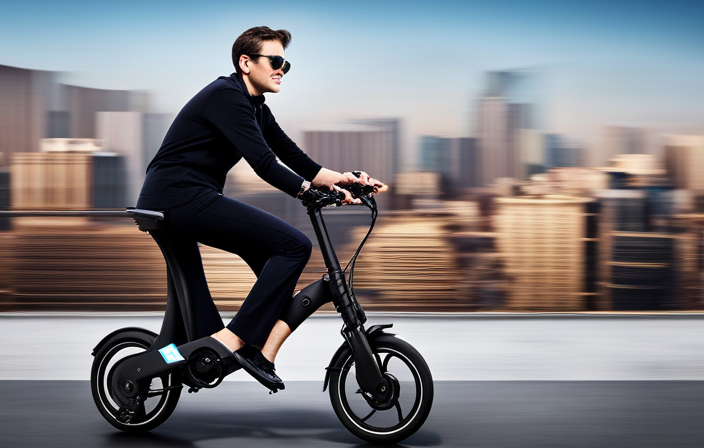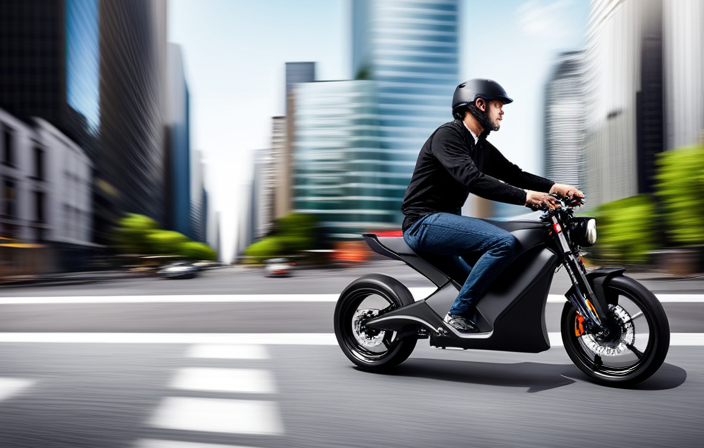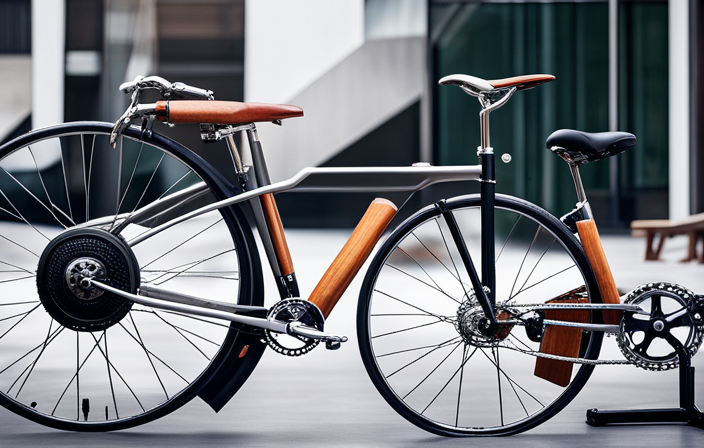Are you aware that the price of charging an electric bike can fluctuate based on various factors?
In this article, I will explore the different aspects that contribute to the overall cost of charging an electric bike.
From electricity rates in your area to the battery capacity and charging time, we will delve into the details to help you understand how much it truly costs to keep your electric bike powered up.
So, let’s dive in and uncover the facts about charging an electric bike.
Key Takeaways
- Electricity rates vary based on location, time of day, and provider.
- Different areas offer discounted rates for electric vehicle charging.
- Battery capacity determines the distance you can travel on a single charge.
- Find the right balance between convenience and battery health for optimal performance.
Electricity rates in your area
Electricity rates in your area can greatly impact the cost of charging an electric bike. When considering the cost of charging your electric bike, it’s important to take into account the electricity consumption and the charging infrastructure available to you.
The electricity rates in your area will determine how much you will be paying per kilowatt-hour (kWh) of electricity used to charge your bike. Different areas have different electricity rates, which can vary depending on factors such as location, time of day, and the type of electricity provider. It’s worth looking into the rates in your area to understand how they will affect your overall costs.
Some areas offer discounted rates for electric vehicle charging, which can significantly reduce the cost of charging your electric bike. In addition to the electricity rates, the availability and quality of the charging infrastructure in your area are also important factors to consider. Having easy access to charging stations can make charging your electric bike more convenient, especially if you need to charge it while you’re out and about.
It’s important to research the charging infrastructure in your area and find out if there are enough charging stations available for your needs. Considering the electricity rates and the charging infrastructure available to you will give you a better understanding of the overall cost of charging your electric bike.
Now, let’s move on to the next section, where we will explore the impact of battery capacity and charging time on the cost.
Battery capacity and charging time
To get the most out of your electric bike, you’ll want to consider the battery’s capacity and how long it takes to charge. The battery capacity determines how far you can go on a single charge, so it’s important to choose a battery that suits your needs. A larger capacity battery will allow for longer rides without needing to recharge.
Additionally, it’s important to consider the charging time of the battery. Some batteries can be fully charged in just a few hours, while others may take longer. This is especially important if you rely on your electric bike for daily transportation and need a quick turnaround time for charging.
It’s also worth noting that the battery lifespan can be affected by how often and how quickly it is charged. The charging infrastructure in your area is another factor to consider. If there are plenty of charging stations available, you can easily charge your bike on the go. On the other hand, if charging stations are limited, you may need to plan your rides around the availability of charging points.
Considering these factors will help you make the most of your electric bike and ensure that you have a reliable and efficient charging experience. When it comes to the frequency of charging, it’s important to find a balance between convenience and battery health.
Frequency of charging
Finding the right balance between convenience and battery health is crucial when considering how often to charge your electric bike. The frequency of charging depends on various factors, including battery life and charging infrastructure availability.
It is important to understand that overcharging or undercharging your electric bike’s battery can have negative impacts on its overall lifespan. On one hand, charging your battery too frequently can lead to premature wear and reduce its overall capacity over time. On the other hand, waiting until the battery is completely drained before charging can also have negative effects.
It is recommended to charge your electric bike when the battery level drops to around 20-30% to maintain its optimal health. Additionally, consider the availability of charging infrastructure in your area. If there are convenient charging stations nearby, you might be able to charge your bike more frequently without worrying about running out of power.
In conclusion, finding the right balance and charging your electric bike based on battery life and charging infrastructure availability will help ensure its longevity and performance.
Transitioning into the subsequent section about the energy efficiency of the electric bike, it is important to consider how efficiently your bike utilizes the energy stored in its battery.
Energy efficiency of the electric bike
Transitioning into the subsequent section about the energy efficiency of the electric bike, it is important to consider how efficiently your bike utilizes the energy stored in its battery. The energy consumption and charging efficiency of an electric bike play a significant role in determining its overall performance and cost-effectiveness.
To better understand the energy efficiency of an electric bike, let’s take a look at the table below:
| Model | Energy Consumption (Wh/km) | Charging Efficiency (%) |
|---|---|---|
| Model A | 10 | 90 |
| Model B | 12 | 85 |
| Model C | 8 | 95 |
| Model D | 15 | 80 |
The table provides information on the energy consumption, measured in watt-hours per kilometer (Wh/km), and the charging efficiency, expressed as a percentage, for different electric bike models. As we can see, Model C has the lowest energy consumption and the highest charging efficiency, making it the most energy-efficient option.
By choosing an electric bike with lower energy consumption and higher charging efficiency, you can maximize the range of your bike and minimize the cost of charging. This not only helps you save money in the long run but also reduces your carbon footprint.
Transitioning into the subsequent section about the cost of a replacement battery, it is essential to consider the financial aspect of owning an electric bike without compromising its performance.
Cost of a replacement battery
The cost of replacing a battery for your e-bike can vary depending on the model and brand. Here are three important factors to consider when it comes to the cost of a replacement battery:
-
Battery lifespan: The lifespan of an e-bike battery can range from 500 to 1,000 charge cycles, depending on the quality and usage. Higher-end batteries tend to have a longer lifespan, which means you may not need to replace them as frequently.
-
Brand and model: Different e-bike brands and models have different battery specifications and prices. It’s essential to research and compare prices before making a purchase. Cheaper options may have a shorter lifespan, while more expensive ones may last longer and offer better performance.
-
Cost-effective alternatives: Instead of replacing the entire battery, you can explore cost-effective alternatives such as replacing individual battery cells. This can be a more affordable option, especially if only a few cells are faulty.
Considering these factors can help you make an informed decision about replacing your e-bike battery. Now, let’s transition to the next section, where we will discuss the impact of the type of charger used on the overall cost of charging an electric bike.
Type of charger used
Using a higher-quality charger can extend the lifespan of the battery for your e-bike. The charger wattage plays a significant role in the charging speed and overall efficiency. Higher wattage chargers can charge your battery faster, while lower wattage chargers will take longer. It is important to note that using a charger with a wattage that is too high for your battery can cause damage, so it’s essential to check the manufacturer’s recommendations.
The impact of charger wattage on electric bike charging speed is straightforward. A higher wattage charger will deliver more power to the battery, resulting in a faster charging time. On the other hand, a lower wattage charger will provide less power, leading to a slower charging process. It is crucial to find the right balance between charging speed and battery health.
Transitioning into the next section about charging options, it’s important to consider the different charging options available for your electric bike. These options include home charging and public charging stations.
Charging options (home charging vs. public charging stations)
When considering the charging options for your e-bike, you should weigh the convenience of home charging against the availability of public charging stations. Both options have their advantages and it ultimately depends on your specific needs and preferences. Here are some key factors to consider:
-
Home charging: Charging your e-bike at home is incredibly convenient. You can simply plug it in overnight and wake up to a fully charged battery. This option is especially beneficial if you have a dedicated charging station or outlet at home. It allows you to have full control over the charging process and ensures that your bike is always ready to go when you need it.
-
Workplace charging: If you have the option to charge your e-bike at your workplace, it can be a great alternative to home charging. This is especially advantageous if you have a long commute and need to top up your battery during the day. Many workplaces now offer charging stations for electric vehicles, including e-bikes, making it a convenient option for many riders.
-
Public charging stations: If you don’t have access to home or workplace charging, public charging stations can be a lifesaver. These stations are typically located in public areas such as shopping centers, parking lots, or parks. They allow you to charge your e-bike on the go, giving you the flexibility to venture further and explore new areas without worrying about running out of battery.
-
Fast charging options: Some charging stations offer fast charging options, allowing you to charge your e-bike in a fraction of the time compared to standard charging. These fast charging options are particularly useful if you’re in a hurry or need to quickly top up your battery for a long ride.
-
Availability: Lastly, it’s important to consider the availability of charging options in your area. While home charging may be convenient, if you live in an apartment or don’t have access to a dedicated charging station, public charging stations may be your only option. It’s worth researching the charging infrastructure in your area to determine which option is most feasible for you.
Considering these factors, it’s recommended to evaluate your personal circumstances and choose the charging option that best suits your needs. In the next section, we’ll explore how your usage patterns, such as commuting or leisure riding, can affect your charging requirements.
Usage patterns (commuting vs. leisure riding)
If you’re deciding between commuting or leisure riding, your usage patterns will greatly impact your charging needs. Commuting expenses and leisure activities require different levels of battery power, so it’s important to understand how your usage will affect your charging requirements.
To help visualize the differences, let’s look at a comparison table:
| Usage Pattern | Commuting | Leisure Riding |
|---|---|---|
| Frequency | Daily | Occasional |
| Distance | Short | Long |
| Speed | Moderate | Varied |
| Charging Time | Regular | Infrequent |
As you can see, commuting involves daily travel with shorter distances and moderate speeds. This means you’ll need to charge your electric bike more frequently to ensure it’s ready for your daily commute. On the other hand, leisure riding is more sporadic, with longer distances and varied speeds. This means you may not need to charge your bike as often, as you’ll be using it less frequently.
Now that we’ve discussed the impact of usage patterns on charging needs, let’s move on to the next section, where we’ll explore the distance traveled per charge. Understanding how far your electric bike can go on a single charge is crucial for planning your rides efficiently.
Distance traveled per charge
The distance your e-bike can travel on a single charge will impact your planning and ride efficiency. Electric bike battery life is determined by various factors that affect the range.
One important factor is the capacity of the battery itself. Higher capacity batteries can store more energy, allowing you to travel further on a single charge.
Another factor is the terrain you ride on. Uphill climbs and rough terrain require more power, which can reduce the distance you can travel.
Additionally, your riding style and speed can affect the battery life. Riding at higher speeds or using more assist levels will drain the battery faster.
It’s also important to consider external conditions like temperature. Extremely cold or hot weather can impact the battery’s performance and reduce its range.
By understanding these factors and planning accordingly, you can maximize the distance you can travel on your electric bike.
As we move on to discussing the cost of maintaining and servicing the electric bike, it’s important to note that these factors can also impact the overall cost of ownership.
Cost of maintaining and servicing the electric bike
To keep your e-bike running smoothly, regular maintenance and servicing are necessary. Just like any other mode of transportation, electric bikes require upkeep to ensure optimal performance and longevity.
When it comes to electric bike maintenance costs, there are a few factors to consider. Firstly, routine tasks such as cleaning, lubricating the chain, and checking tire pressure can easily be done by the bike owner and are relatively low-cost. However, for more complex tasks like battery maintenance or motor repairs, it is advisable to seek professional assistance.
While professional servicing may incur additional costs, it can be a cost-effective option in the long run. By identifying and resolving potential issues early on, you can prevent major breakdowns and save money on expensive repairs. Moreover, professional technicians possess the expertise and tools needed to properly service your e-bike, ensuring its optimal performance.
So, while there may be some upfront costs associated with professional servicing, it can ultimately save you money by extending the lifespan of your electric bike and minimizing the need for costly repairs.
Speaking of maintenance, let’s now explore the impact of temperature on battery performance.
Impact of temperature on battery performance
When it comes to maintaining and servicing an electric bike, there are various factors to consider. One important aspect is the impact of temperature on battery performance.
The temperature can have a significant effect on the longevity of the battery and its overall range. Extreme temperatures, whether hot or cold, can negatively impact the battery’s ability to hold a charge. In cold weather, the chemical reactions within the battery slow down, reducing its capacity and range. On the other hand, in hot weather, the battery can overheat, leading to a decrease in its overall lifespan.
To ensure optimal battery performance and longevity, it’s important to store the electric bike in a temperature-controlled environment whenever possible. Avoid exposing it to extreme temperatures for extended periods of time.
Understanding the impact of temperature on battery range is crucial for electric bike owners. By taking proper care of the battery and being mindful of the temperature conditions, riders can maximize their bike’s range and get the most out of their electric bike experience.
Now, let’s explore another important aspect of charging an electric bike: off-peak charging rates.
Off-peak charging rates
Understanding off-peak charging rates is essential for maximizing battery performance and saving money on electricity bills. Off-peak charging refers to charging your electric bike during times when electricity demand is lower, typically during nighttime hours.
Here are some key points to consider:
-
Off-peak charging rates are typically lower than peak rates, which means you can save money on your electricity bills by taking advantage of these lower rates.
-
Charging your electric bike during off-peak hours also helps reduce the strain on the power grid. By spreading out electricity consumption throughout the day, it helps prevent overload during peak demand periods.
-
Many electricity providers offer special off-peak charging programs or time-of-use plans that incentivize customers to shift their electricity usage to off-peak hours.
By understanding and taking advantage of off-peak charging rates, you can both optimize your electric bike’s battery performance and contribute to a more sustainable electricity consumption pattern.
Now, let’s explore the exciting world of solar charging options for electric bikes.
Solar charging options
Solar charging options for electric bikes can be a convenient and eco-friendly way to keep your battery powered up. Many electric bike models are compatible with solar panels, allowing you to harness the power of the sun to charge your bike’s battery. These solar panels can be mounted on rooftops, backpacks, or even directly on the bike itself. They are lightweight and portable, making them ideal for on-the-go charging options.
The solar panel compatibility of electric bikes provides a sustainable alternative to traditional charging methods. By utilizing solar power, you can reduce your reliance on electricity from the grid and decrease your carbon footprint. Additionally, solar charging options allow you to charge your bike anywhere there is sunlight, giving you the freedom to explore without worrying about finding a power outlet.
When comparing the charging costs of electric bikes with other modes of transportation, solar charging options can be particularly cost-effective. While the initial investment in solar panels may be higher, the long-term savings on electricity bills can outweigh the upfront cost. Furthermore, solar energy is renewable and free, making it a more sustainable and affordable option in the long run.
Comparison of charging costs with other modes of transportation
As we explored the options for solar charging, it became evident that there are various ways to power an electric bike sustainably. However, it’s important to consider the charging costs in comparison to other modes of transportation.
When comparing the cost of charging an electric bike to using public transportation, there are several factors to consider:
- Flexibility: With an electric bike, you have the freedom to travel whenever and wherever you want, without relying on public transportation schedules.
- Cost: Charging an electric bike is significantly cheaper than buying a ticket for public transportation, especially in the long run.
- Environmental Impact: Electric bikes produce zero emissions, making them a more eco-friendly option compared to public transportation.
- Health Benefits: Riding an electric bike provides exercise and fresh air, contributing to better physical and mental well-being.
- Convenience: Electric bikes allow for door-to-door transportation, eliminating the need to walk to and from public transportation stops.
Similarly, when comparing the cost of charging an electric bike to car ownership, the advantages of an electric bike become even more apparent:
- Cost Savings: Charging an electric bike is considerably cheaper than fueling a car, and maintenance costs are typically lower as well.
- Parking: Electric bikes require less space to park, making them ideal for crowded urban areas where parking can be a challenge.
- Traffic Congestion: Electric bikes can navigate through traffic more easily than cars, saving time and reducing stress.
- Environmental Impact: Electric bikes have a minimal carbon footprint compared to cars, making them a greener option.
- Health Benefits: Riding an electric bike provides exercise and contributes to overall well-being.
With all these factors taken into account, it’s clear that electric bikes offer significant advantages over public transportation and car ownership in terms of cost, convenience, and sustainability. In the following section, we will delve into the overall cost savings compared to using a traditional bike or car.
Overall cost savings compared to using a traditional bike or car
When comparing the overall cost savings, using a traditional bike or car can be significantly more expensive than using an electric bike. In a comprehensive electric bike cost analysis, it becomes clear that electric bikes offer numerous financial advantages over their counterparts.
Firstly, the upfront cost of an electric bike may seem higher, but when considering the long-term expenses, it becomes evident that electric bikes are a more economical choice. Unlike cars, electric bikes do not require fuel or insurance, significantly reducing ongoing costs. Additionally, maintenance expenses are considerably lower for electric bikes compared to cars, as they have fewer components and simpler mechanics.
Furthermore, electric bikes can be charged using a regular household outlet, which is much more cost-effective than filling up a car’s gas tank. Not only do electric bikes offer significant cost savings, but they also provide environmental benefits. By opting for an electric bike instead of a car, individuals can contribute to reducing air pollution and greenhouse gas emissions.
Frequently Asked Questions
Are there any solar charging options available for electric bikes?
Yes, there are solar charging options available for electric bikes. Solar charging benefits include being environmentally friendly and cost-effective in the long run.
With solar charging infrastructure, you can harness the power of the sun to charge your electric bike’s battery. This allows you to charge your bike wherever there is sunlight, reducing your reliance on traditional charging methods and providing a sustainable energy solution.
How does the cost of charging an electric bike compare to the cost of charging other modes of transportation?
When comparing the cost of charging an electric bike to other modes of transportation, it’s important to consider the charging efficiency.
For example, let’s say we have an electric car and an electric bike. The electric car may have a higher charging cost due to its larger battery capacity and longer charging time.
On the other hand, the electric bike typically has a smaller battery and charges faster, resulting in lower charging costs.
Overall, the cost comparison depends on the specific vehicle and its charging efficiency.
What are the overall cost savings of using an electric bike compared to using a traditional bike or car?
Using an electric bike instead of a traditional bike or car can result in significant cost savings. The cost of maintenance for electric bikes is generally lower compared to cars, as they have fewer moving parts and require less frequent servicing.
Additionally, electric bikes offer environmental benefits by reducing greenhouse gas emissions. These savings, both in terms of money and the environment, make electric bikes a more cost-effective and sustainable mode of transportation.
How does the distance traveled per charge vary based on the usage patterns of the electric bike?
The distance traveled per charge of an electric bike can vary greatly depending on the usage patterns. Just like a river flowing through different landscapes, an electric bike’s range ebbs and flows with how it’s ridden.
Factors such as speed, terrain, and frequency of acceleration can all impact the distance you can cover on a single charge. Understanding your usage patterns and adjusting your riding style accordingly can help you maximize the distance per charge and extend your electric biking adventures.
What is the impact of temperature on the performance of the electric bike’s battery?
The performance of an electric bike’s battery is significantly influenced by temperature. Extreme temperatures, whether hot or cold, can negatively affect the battery’s performance.
In cold weather, the battery may experience reduced efficiency and lower overall range. Conversely, in hot weather, the battery may degrade faster and have a shorter lifespan.
It is important to keep the bike and battery at a moderate temperature to ensure optimal battery performance and longevity.
Conclusion
After considering all the factors, it’s clear that charging an electric bike is a cost-effective and environmentally friendly option. With the right electricity rates, efficient battery capacity, and smart charging habits, the cost of charging an electric bike can be minimal.
It’s like fueling your bike with a never-ending supply of energy, like a river flowing effortlessly. And when compared to the expenses of a traditional bike or car, the savings are truly remarkable.
So why not embrace this electrifying ride and be a part of the sustainable future?









